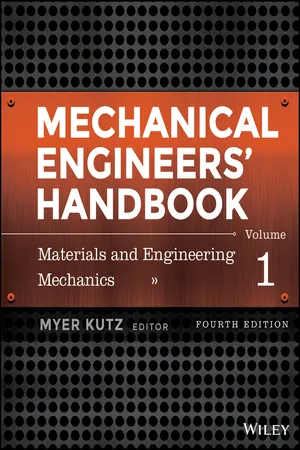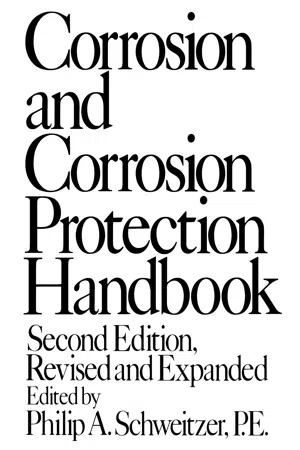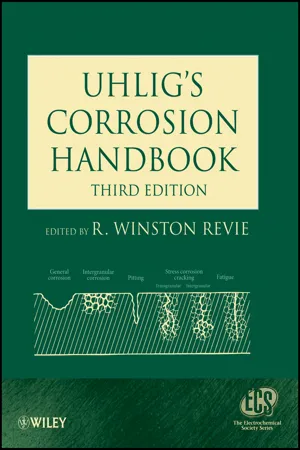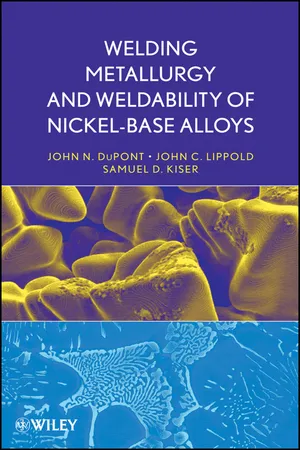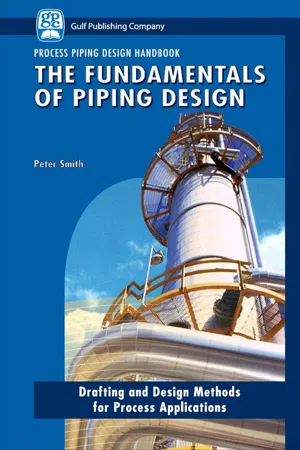Technology & Engineering
Nickel Alloys
Nickel alloys are metallic materials that contain nickel as the primary element, often combined with other metals such as chromium, iron, or copper. These alloys are known for their exceptional resistance to corrosion, high-temperature strength, and excellent performance in extreme environments. They are widely used in various industries, including aerospace, chemical processing, and marine engineering, due to their unique combination of properties.
Written by Perlego with AI-assistance
Related key terms
Related key terms
1 of 4
Related key terms
1 of 3
6 Key excerpts on "Nickel Alloys"
- eBook - ePub
Mechanical Engineers' Handbook, Volume 1
Materials and Engineering Mechanics
- Myer Kutz, Myer Kutz(Authors)
- 2015(Publication Date)
- Wiley(Publisher)
Of importance for aqueous reducing acids, oxidizing chloride environments, and seawater are alloy 625 and alloy C-276, which contain 9 and 16% molybdenum, respectively, and are among the most resistant alloys currently available. Low-level titanium and aluminum additions provide V strengthening while retaining good corrosion resistance, as in alloy X-750. Cobalt and other alloying element additions provide jet engine materials (superalloys) that combine high-temperature strength with resistance to gaseous oxidation and sulfidation.Another technologically important group of materials are the higher iron alloys, which were originally developed to conserve nickel and are often regarded as intermediate in performance and cost between Nickel Alloys and stainless steels. The prototype, alloy 800 (Fe– 33% Ni–21% Cr), is a general-purpose alloy with good high-temperature strength and resistance to steam and oxidizing or carburizing gases. Alloying with molybdenum and chromium, as in alloy 825 and alloy G, improves resistance to reducing acids and localized corrosion in chlorides.Another important category is the nickel–copper alloys. At the higher nickel end are the Monel alloys (30–45% Cu, balance Ni) used for corrosive chemicals such as hydrofluoric acid and severe marine environments. At the higher copper end are the cupronickels (10– 30% Ni, balance Cu), which are widely used for marine applications because of their fouling resistance.Nickel Alloys exhibit high resistance to attack under nitriding conditions (e.g., in dissociated ammonia) and in chlorine or chloride gases. Corrosion in the latter at elevated temperatures proceeds by the formation and volatilization of chloride scales, and high-nickel contents are beneficial since nickel forms one of the least volatile chlorides. Conversely, in sulfidizing environments, high-Nickel Alloys without chromium can exhibit attack due to the formation of a low-melting-point Ni–Ni3 Si2 eutectic. However, high chromium contents appear to limit this form of attack.Friend explains corrosion reactions as wet or dry (Ref. 10, pp. 3–5):The term wet corrosion usually refers to all forms of corrosive attack by aqueous solutions of electrolytes, which can range from pure water (a weak electrolyte) to aqueous solutions of acids or bases or of their salts, including neutral salts. It also includes natural environments such as the atmosphere, natural waters, soils, and others, irrespective of whether the metal is in contact with a condensed film or droplets of moisture or is completely immersed. Corrosion by aqueous environments is electrochemical in nature, assuming the presence of anodic and cathodic areas on the surface of the metal even though these areas may be so small as to be indistinguishable by experimental methods and the distance between them may be only of atomic dimensions. - eBook - ePub
- David E.J. Talbot, James D.R. Talbot(Authors)
- 2018(Publication Date)
- CRC Press(Publisher)
Nickel forms extensive solid solutions in binary systems with other passivating metals including copper, chromium, iron, molybdenum and cobalt, which form the basis of most alloys. Compositions of interest lie within the solid solution phase fields of the binary systems, but most alloys are multicomponent formulations and contain additional components selected from aluminium, titanium, tantalum, niobium and carbon that may be added to enhance resistance to corrosion or oxidation or to improve mechanical properties. Such constitutions are often too complex to represent in simple phase equilibrium diagrams.Nickel Alloys are of two different kinds:1.Alloys for general corrosion resistance in aggressive chemical engineering, industrial and marine environments, which are essentially solid solutions with simple structures designed to passivate in prescribed media.2.Customized alloys for blades and associated components operating at high temperatures in gas turbines for aircraft and marine propulsion, known as superalloys . They are complex highly specialized alloys, some consisting of as many as ten components, with chemical compositions and controlled microstructures designed to maintain mechanical stability and chemical integrity in the unique environments of gas turbine flames derived from aviation or marine fuels and air ingested from prevailing ambient atmospheres.11.2.1Nickel Alloys for General Corrosion ResistanceAlloys for chemical engineering, marine and allied applications have evolved by progressive improvements based on information accumulated from service experience and plant and laboratory corrosion tests. Tables 11.1 and 11.2 list compositions for some representative alloys and corresponding mechanical properties typical of the many registered formulations available. The properties are comparable with those of carbon steels.The list includes alloys that can be matched to applications in acidic, alkaline or neutral aqueous media, including hydrochloric acid, for wide ranges of compositions and temperature, and to reactive gases including chlorine, hydrogen chloride and fluorine. The selection of a reliable and economic alloy for any particular application is usually guided by experience and confirmed by extensive experimental and plant tests because the conditions in which they must serve are often too complex and variable to predict in advance. Environmental factors that must be considered include pH, temperature, speciation, prevailing redox potentials and degree of aeration, all of which may vary in the course of process sequences in chemical or related industries. Other factors may also be important such as acceptable metallic contamination of material in process. - eBook - ePub
- Schweitzer(Author)
- 2017(Publication Date)
- Routledge(Publisher)
7Nickel and High Nickel Alloys N. Sridhar Heynes International, Inc., Kokomo, Indiana F. Galen Hodge Heynes International, Inc., Kokomo, IndianaIntroduction
No class of alloys shows as wide a range of applications as the Ni-based alloys. These alloys are used as corrosion-resistant alloys, heating elements, controlled expansion alloys, creep-resistant alloys in turbines and jet engines, and high-temperature corrosion-resistant alloys. What makes this array of applications possible is not only the electrochemical properties of nickel but also its crystallographic characteristics that enable it to accommodate large amounts of alloying elements that, in turn, lend these alloys their unique properties. This chapter will be devoted to the alloys developed mainly for their corrosion resistance. These alloys are mainly solid-solution-strengthened alloys supplied in the fully annealed condition. However, some precipitation hardenable Ni-based alloys will also be discussed where their corrosion properties are of importance. The purpose overall will be to present the strengths and weaknesses of these alloys and their areas of application. Discussion of corrosion mechanisms and physical metallurgy will be kept to a minimum. However, references, which elaborate the physical metallurgy and corrosion mechanisms, are cited under each alloy category.The element nickel is nobler than iron but more active than copper in the electrochemical series. In reducing environments, such as dilute sulfuric acid, nickel is more corrosion-resistant than iron but not as resistant as copper or nickel-copper alloys. The nickel-molybdenum alloys are more corrosion-resistant to reducing acids than nickel or Ni-Cu alloys. Nickel can form a protective, passive film in some environments and, hence, exhibit moderate corrosion resistance. However, the passive film is not particularly stable and, hence, nickel cannot generally be used in oxidizing environments such as nitric acid. Alloying with chromium can result in a much more stable passive film and corrosion resistance to a variety of oxidizing environments. However, the nickel-chromium alloys can corrode in environments containing appreciable amounts of chloride or other halides, especially if oxidizing species are present. The form of corrosion will be pitting. Alloying with molybdenum and tungsten is necessary to improve the resistance to corrosion by oxidizing chloride solutions. - eBook - ePub
- R. Winston Revie, R. Winston Revie(Authors)
- 2011(Publication Date)
- Wiley(Publisher)
2 S >260°C, by oxygen or air > 540°C, and by nitrogen > 980°C. The new technologies of thermal destruction of hazardous and municipal waste, fluidized-bed combustion, coal gasification and chemicals from coal processes, and the use of “dirty feedstock,” such as heavy oil and high sulfur coal, coupled with demands for higher efficiency and tougher environmental regulations, have necessitated the use of higher alloy systems of iron-, nickel-, and cobalt-base alloys. Alloy systems must provide reliable and safe performance in a cost-effective manner but must also have sufficient versatility to resist changing corrosive conditions due to feedstock changes. The property requirements in materials of construction for high-temperature applications can be classified under mechanical and high-temperature corrosion resistance as follows:
Requirements will vary for different industries, such as aerospace, heat treating, power generation, and chemical/petrochemical processing.Mechanical Properties Corrosion Resistance Properties High-temperature strength Oxidation Stress rupture strength Carburization Creep strength Nitriding Fatigue strength Sulfidation Thermal stability Halogenation Thermal shock resistance Molten salt Toughness Liquid metal Other specific properties Ash salt deposit Others In nickel-base alloys, the major elements for imparting specific properties or a combination of properties are chromium, silicon, aluminum, titanium, molybdenum, cobalt, tungsten, and carbon. Others, such as yttrium and rare earths, niobium, tantalum, and zirconium, play very specific roles in improving certain high-temperature corrosion characteristics. These alloying elements can also be classified as follows:
References [10, 39–42] provide detailed information on high-temperature alloy systems. NoteProtective scale formers Cr as Cr2 O3 , Al as Al2 O3 , Si as SiO2 Solid-solution strengtheners Mo, W, Nb, Ti, Cr, Co Age-hardening strengtheners Al + Ti, Al, Ti, Nb, Ta Carbide strengtheners Cr, Mo, W, Ti, Zr, Ta, Nb Improved scale adhesion (spallation resistance) Rare earths (La, Ce) Y, Hf, Zr, Ta 1. Deceased.References1. Bulletin CEB-2 “Corrosion Resistance of Nickle and Nickle-Containing Alloys in Caustic Soda and Other Alkalies,” International Nickle Co., Inc., Huntington, WV, 1973.2. D. C. Agarwal, U. Heubner, M. Koehler,and W. Herda, Mater. Perform. , 33 (10), 64 (1994).3. - John C. Lippold, Samuel D. Kiser, John N. DuPont(Authors)
- 2011(Publication Date)
- Wiley(Publisher)
The compositions of a number of popular nickel-chromium, nickel-chromium-iron, and nickel-chromiummolybdenum alloys are listed in Table 3.2. Alloys with additions of molybdenum are widely used for improved aqueous corrosion resistance. In some cases, molybdenum also provides strength at elevated temperatures, but limits the upper range of application due to its tendency for severe oxidation above about 1150 °C (2100 °F). TABLE 3.1 Composition of Ni and Ni-Cu Alloys. A A Single value is a maximum. There are also a number of iron Nickel Alloys that are technically ironbased, but contain very high levels of nickel (30–45 wt%) and are often listed in handbooks along with true Ni-base alloys. Compositions of some of these alloys are also listed in Table 3.2. These include iron nickel chromium alloys that are used for elevated temperature applications and exhibit corrosion properties intermediate between the austenitic stainless steels and Ni Cr Fe alloys, including the popular grades 800, 800H and 825. These intermediate Ni containing alloys and other specialty steels are often welded using Ni-base filler metals in order to achieve weld metal properties that match or exceed those of the base metal in the as welded condition. Examples include: 1) the use of Ni Cr consumables for welding 9% nickel steel for excellent as welded impact strength at cryogenic temperatures, 2) welding Alloy 800H with Ni-Cr-Co-Mo consumables to provide overmatching creep strength above 870 °C (1600 °F), and 3) welding superduplex and superaustenitic stainless steels with Ni-Cr-Mo alloys for overmatching pitting resistance in the as welded condition. A number of nickel-iron, nickel molybdenum, and iron Nickel Alloys are listed in Table 3.3. The nickel-molybdenum “B” alloys contain virtually no chromium and were developed to resist various acids, including hydrochloric, sulfuric, acetic, and phosphoric- eBook - ePub
- Peter Smith(Author)
- 2013(Publication Date)
- Gulf Publishing Company(Publisher)
Super stainless steels are used when austenitic and ferritic/austenitic stainless steels are inadequate to withstand corrosion attack. They contain very large percentages of nickel or chrome and molybdenum. This makes them much more expensive than the usual 300 series alloys and not as readily available. These alloys include alloy 20 and Hastelloy.Alloy steels are considered to be steels to which one or more alloying elements, other than carbon, have been added to give them mechanical and chemical properties that are different than those of carbon steels.Steel is considered an alloy steel when the levels of manganese, silicon, or copper exceed the maximum limits for the carbon steels or when minimum quantities of other alloying elements, such as chromium, molybdenum, nickel, copper, cobalt, niobium, vanadium, or others, are added intentionally.The higher levels of alloying in steels used in the piping industry are ferritic and martensitic stainless steels. These are steels alloyed with chromium contents above about 12%. The presence of chromium gives these steels good corrosion resistance, which increases with the addition of more chromium.Austenitic stainless steels are the ones most commonly used in the process industry, and they possess an excellent combination of strength, ductility, and corrosion resistance.These materials are referred to as precipitation hardenable stainless steels.
Index pages curate the most relevant extracts from our library of academic textbooks. They’ve been created using an in-house natural language model (NLM), each adding context and meaning to key research topics.
Explore more topic indexes
Explore more topic indexes
1 of 6
Explore more topic indexes
1 of 4
